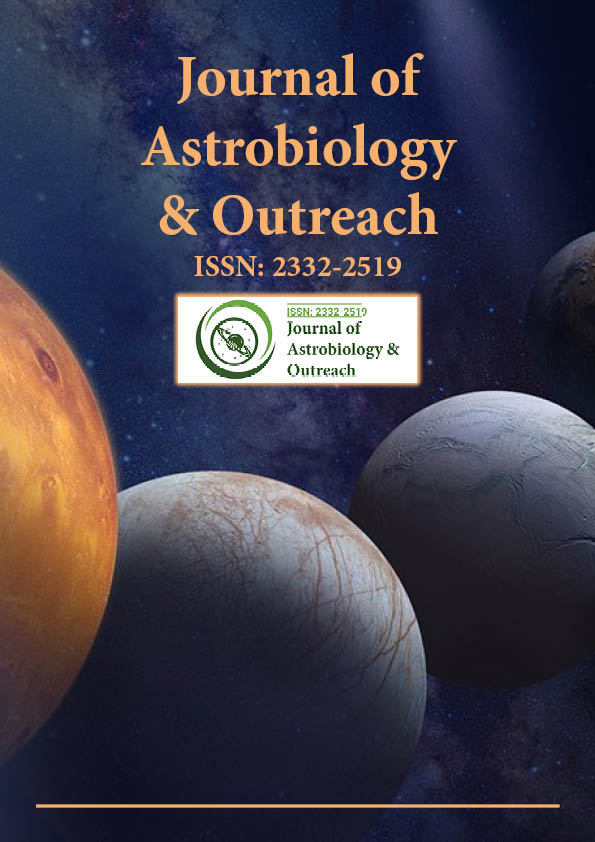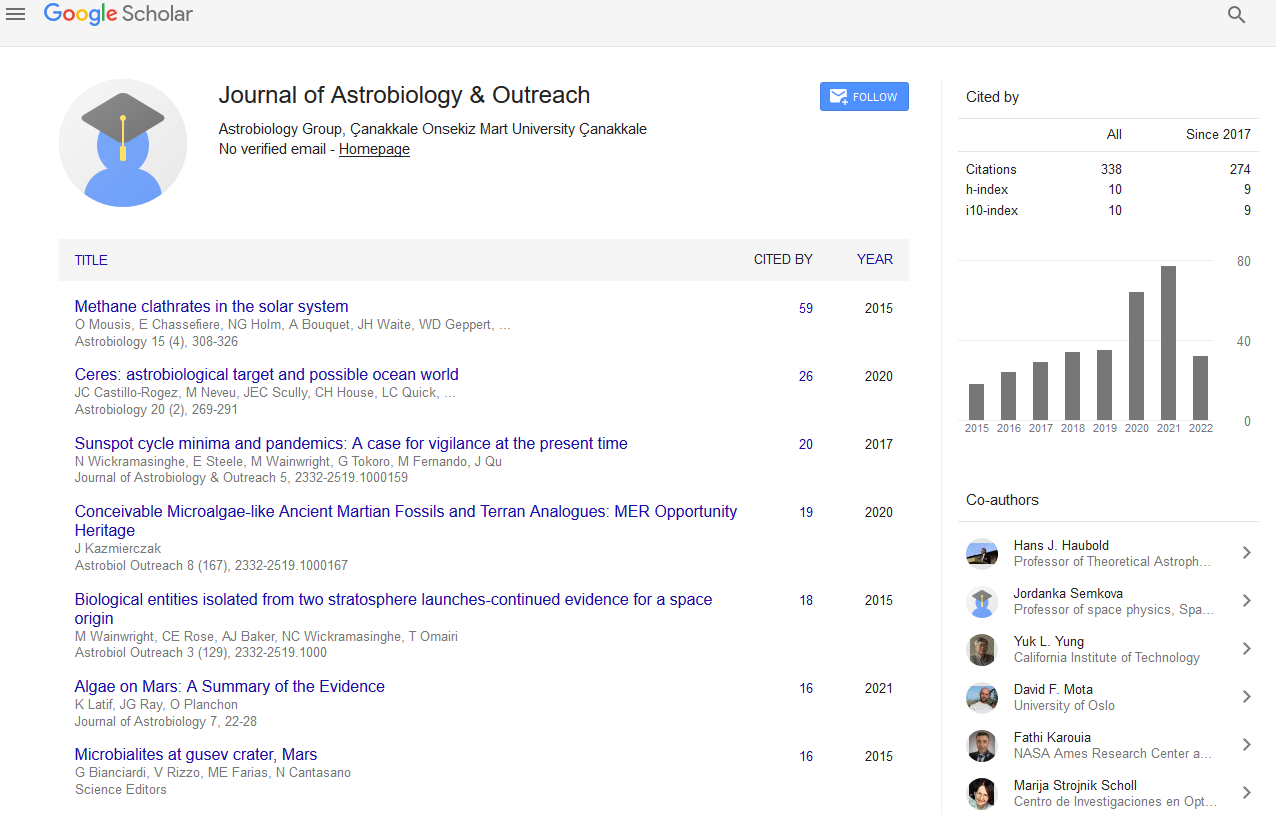Indexed In
- Open J Gate
- Academic Keys
- JournalTOCs
- RefSeek
- Hamdard University
- EBSCO A-Z
- OCLC- WorldCat
- Google Scholar
Useful Links
Share This Page
Journal Flyer

Open Access Journals
- Agri and Aquaculture
- Biochemistry
- Bioinformatics & Systems Biology
- Business & Management
- Chemistry
- Clinical Sciences
- Engineering
- Food & Nutrition
- General Science
- Genetics & Molecular Biology
- Immunology & Microbiology
- Medical Sciences
- Neuroscience & Psychology
- Nursing & Health Care
- Pharmaceutical Sciences
Perspective - (2024) Volume 12, Issue 4
Overcoming Atmospheric Distortions in Ground-Based Observations of Jupiter and Saturn
Aoife Byrne*Received: 29-Nov-2024, Manuscript No. JAO-24-28011; Editor assigned: 02-Dec-2024, Pre QC No. JAO-24-28011 (PQ); Reviewed: 16-Dec-2024, QC No. JAO-24-28011; Revised: 23-Dec-2024, Manuscript No. JAO-24-28011 (R); Published: 30-Dec-2024, DOI: 10.35248/2332-2519.24.12.364
Description
Ground-based measurements of the millimeter to sub-millimeter spectrum of gas giants such as Jupiter and Saturn play an essential role in advancing our understanding of planetary atmospheres. The 1.3 to 0.3 mm spectral range is particularly important as it provides critical insights into the chemical composition, temperature profiles and mechanisms processes occurring in these different planets. However, the effectiveness of these measurements heavily depends on the calibration of the instrumentation used, ensuring the reliability and accuracy of the data collected. This article explains the significance of ground-based spectral measurements, the challenges involved and the importance of detailed calibration to achieve meaningful scientific results.
Jupiter and Saturn, the two largest planets in our solar system, are primarily composed of hydrogen and helium, with trace amounts of methane, ammonia and other gases. The millimeter and sub-millimeter wavelengths are essential for studying these molecules in the planets’ atmospheres. By examining the spectra in the 1.3 to 0.3 mm range, researchers can gain valuable information on the distribution and presence of fundamental compounds that control planetary weather systems, cloud formation and chemical interactions. Ground-based observatories, such as radio telescopes, are particularly effective in capturing emissions at these wavelengths, as they can peer through the outer layers of the atmosphere, providing an insight into the deeper regions of these planets.
One of the major challenges in obtaining accurate spectral data from ground-based observations is the distortion caused by Earth’s atmosphere. Water vapor, oxygen and other atmospheric components can interfere with the incoming radiation from different planets, making it necessary to account for these factors in the calibration process. Atmospheric correction techniques are therefore important in ensuring that the data reflects the true properties of Jupiter and Saturn, rather than being biased by Earth’s own atmospheric conditions. Without these adjustments, the measurements could become inaccurate, leading to inaccurate conclusions about the planets’ composition and behavior.
To minimize these challenges, detailed calibration procedures are implemented. These include atmospheric models that correct for the effects of water vapor absorption and diffusion. These models are based on real-time data of Earth’s atmospheric conditions, which helps account for any variations in the water vapor content and its impact on the observed signal. Moreover, instruments used for ground-based spectral observations require precise calibration to account for their own unique characteristics, such as spectral resolution, sensitivity and wavelength response. This requires a thorough understanding of the instrument’s performance under various observation conditions.
For accurate flux calibration, a comparison with well-established calibration sources, such as stars or other celestial bodies with known flux values, is necessary. By using these reference sources, researchers can convert the raw data into meaningful measurements of intensity. These calibration sources not only help in flux calibration but also ensure that the instrument’s response is consistent and reproducible across different observations. Further, the pointing accuracy of the telescope and antenna gain must be carefully considered to eliminate any potential instrumental errors that could affect the final data quality.
The scientific value of ground-based measurements, particularly in the 1.3 to 0.3 mm range, extends beyond the direct study of Jupiter and Saturn. These observations provide important context for understanding exoplanets with similar atmospheric conditions, which can inform future studies of planets orbiting distant stars. Given the potential for discovering habitable exoplanets, the calibration of ground-based instruments is not only a matter of refining the study of planets within our solar system but also a critical step in advancing our exploration of the broader universe.
As technology progresses, future improvements in both the sensitivity and resolution of ground-based instruments will improve our ability to capture detailed spectra of Jupiter and Saturn. New calibration techniques, such as the use of advanced atmospheric models and the development of more precise instruments, will allow for increasingly accurate measurements. These advancements will further our understanding of the chemical and physical processes that control the behavior of gaseous planets and provide a more detailed picture of their atmospheres.
In conclusion, ground-based measurements of the 1.3 to 0.3 mm spectrum of Jupiter and Saturn, when combined with detailed calibration efforts, provide critical insights into the atmospheres of these gas giants. Through careful calibration and data interpretation, these observations allow for a deeper understanding of planetary chemistry, weather patterns and the fundamental processes that form these different worlds. As technology advances, the continued refinement of these calibration techniques will only improve our ability to study Jupiter, Saturn and other similar planetary systems, contributing to a greater understanding of the formation and evolution of planetary atmospheres both within our solar system and beyond.
Citation: Byrne A (2024). Overcoming Atmospheric Distortions in Ground-Based Observations of Jupiter and Saturn. J Astrobiol Outreach. 12:364.
Copyright: © 2024 Byrne A. This is an open-access article distributed under the terms of the Creative Commons Attribution License, which permits unrestricted use, distribution, and reproduction in any medium, provided the original author and source are credited.

